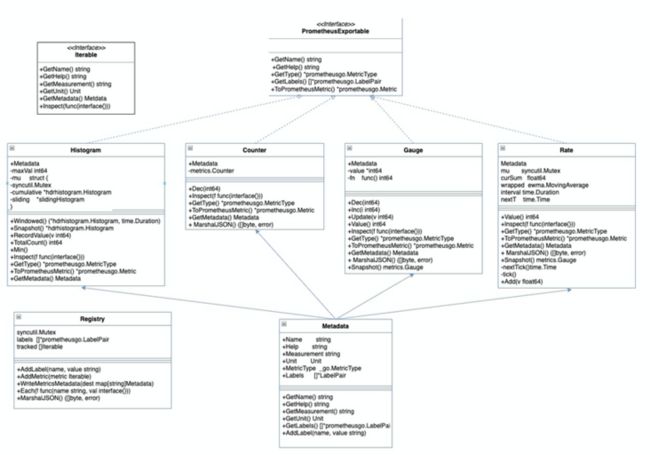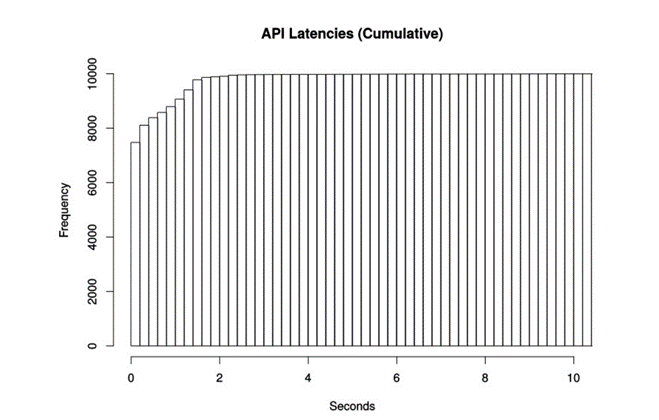分布式系统的监控告警及运维服务离不开指标监控,开务作为浪潮自主研发的一款分布式数据库自然也不例外。在兼顾强一致性、高可用分布式架构、在线水平扩展、企业级安全等特性下,开务的 metric 模块可提供监控指标,实现预先定义指标的周期性采集。同时,可以提供兼容 Prometheus 标准格式的 API 接口,方便与外部的 Prometheus 服务进行集成。
开务数据库 metric 模块收集各模块相关统计的 metric 信息,并将其作为 Prometheus 格式的指标储存起来用于进一步查阅,对判断开务数据库的运行情况有着重要作用,同时也是开务数据库 adminUI 指标的数据来源。本期内容将围绕下图展示的 metric 模块基本框架,带领大家深入了解开务数据库 metric 模块的源码,图中各模块的详细介绍将持续为大家更新。
1、定义接口介绍
1.IterableIterable
IterableIterable提供了一个同步访问内部对象的方法。方法如下:
GetName() string 返回指标名
GetHelp() string 返回指标帮助文本
GetMeasurement() string 返回指标的lable
GetUnit() Unit 返回指标使用的单位
GetMetadata() Metdata 返回指标的Metadata
Inspect(func(interface{})) Inspect对每个包含的项调用给定的闭包2.PrometheusExportable
PrometheusExportable 是标准独立指标接口,可供指标导入 Prometheus。方法如下:
GetName() string 返回指标名
GetHelp() string 返回指标帮助文本
GetType() *prometheusgo.MetricType 返回指标的Prometheus类型
GetLables() []*prometheusgo.LabelPair Metadata中的一个方法,返回指标的标签
ToPrometheusMetric() *prometheusgo.Metric 返回一个完成值填充的Prometheus指标3.PrometheusIterable
PrometheusIterable 是 PrometheusExportable 的扩展,用于指示该指标由增加父标签值的子指标组成。包含成员:PrometheusExportable。方法如下:
Each([]*prometheusgo.LabelPair, func(metric *prometheusgo.Metric))
“Each”获取与父指标相关联的标签对切片,并使用每个子指标调用所传递的函数2、Metric Metadata介绍
Metadata 包含关于指标的元数据,它必须嵌入到每个 metric object 中。它用于将有关指标的信息导出到 Promethues 和 adminUI 图表。
type Metadata struct {
Name string
Help string
Measurement string
Unit Unit
MetricType _go.MetricType
Labels []*LabelPair
}
// 方法
GetName() string
GetHelp() string
GetMeasurement() string
GetUnit() Unit
GetLabels() []*prometheusgo.LabelPair
Addlabel(name value string)//给一个指标添加标签/值映射3、指标类型介绍
1.HistogramHistogram
在一段时间范围内对数据进行采样(通常是请求持续时间、响应大小等),并将其计入可配置的存储桶(bucket)中,后续可通过指定区间筛选样本,也可以统计样本总数,最后一般将数据展示为直方图。
Prometheus 的 Histogram 是一种累积直方图,与上面的区间划分方式是有差别的。它的划分方式如下:假设每个 bucket 的宽度是 0.2s,那么第一个 bucket 表示响应时间小于等于 0.2s 的请求数量,第二个 bucket 表示响应时间小于等于 0.4s 的请求数量,以此类推。也就是说,每一个 bucket 的样本包含了之前所有 bucket 的样本,所以叫累积直方图。
type Histogram {
Metadata
maxVal int64
mu struct {
syncutil.Mutex
cumulative *hdrhistogram.Histogram
sliding *slidingHistogram
}
//hdrhistogram.Histogram
type Histogram struct {
lowestTrackableValue int64
highestTrackableValue int64
unitMagnitude int64
significantFigures int64
subBucketHalfCountMagnitude int32
subBucketHalfCount int32
subBucketMask int64
subBucketCount int32
bucketCount int32
countsLen int32
totalCount int64
counts []int64
}
//slidingHistogram
type slidingHistogram struct {
windowed *hdrhistogram.WindowedHistogram
nextT time.Time
duration time.Duration
}
type WindowedHistogram struct {
idx int
h []Histogram
m *Histogram
Current *Histogram
}
//相关方法介绍
func (h *Histogram) Windowed() (*hdrhistogram.Histogram, time.Duration)
返回一份当前的窗口化直方图的数据和其中的时间间隔
func (h *Histogram) Snapshot() *hdrhistogram.Histogram
返回累积(即所有样本)直方图数据的副本
func (h *Histogram) RecordValue(v int64)
RecordValue将给定的值添加到直方图。记录超过该直方图配置最大值使用方法
func (h *Histogram) TotalCount() int64
TotalCount返回样本的(累计)数量
func (h *Histogram) Min() int64
返回最小值
func (h *Histogram) Inspect(f func(interface{}))
调用带有空字符串和接收方的闭包
func (h *Histogram) GetType() *prometheusgo.MetricType
返回此指标的Prometheus类型enum
func (h *Histogram) ToPrometheusMetric() *prometheusgo.Metric
返回正确类型的已填充的Prometheus度量值
func (h *Histogram) GetMetadata() Metadata
返回指标的元数据,包括Prometheus MetricType
func NewHistogram(metadata Metadata, duration time.Duration, maxVal int64, sigFigs int) (*Histogram)
实例化一个新histogram
func NewLatency(metadata Metadata, histogramWindow time.Duration) *Histogram
NewLatency
返回一个带有适当默认值的直方图来跟踪延迟。数值以ns表示,截断为间隔[0,MaxLatency],并以1位精度记录(即误差在100ms时<10ms,在60s时<6s)2.Counter
Counter 类型代表一种样本数据单调递增的指标,即只增不减,除非监控系统发生了重置。例如,你可以使用 Counter 类型的指标来表示服务的请求数、已完成的任务数、错误发生的次数等。
type Counter struct {
Metadata
metrics.Counter
}
type Counter interface {
Clear()
Count() int64
Dec(int64)
Inc(int64)
Snapshot() Counter
}
//相关方法介绍
func (c *Counter) Dec(int64)
Dec重载了metric.Counter的方法。不能使用这种方法,它只用于防止误用metric类型
func (c *Counter) GetType() *prometheusgo.MetricType
返回此指标的Prometheus类型enum
func (c *Counter) Inspect(f func(interface{}))
调用带有空字符串和接收方的闭包,即返回自己c
func (c *Counter) MarshalJSON() ([]byte, error)
MarshalJSON将数据封装到JSON
func (c *Counter) GetMetadata() Metadata
返回指标的元数据,包括Prometheus MetricType3.Gauge
Gauge 类型代表一种样本数据可以任意变化的指标,即可增可减。Guage 通常用于像温度或者内存使用率这种指标数据,也可以表示能随时增加或减少的“总数”,例如:当前并发请求的数量。
type Gauge struct {
Metadata
value *int64
fn func() int64
}
//相关方法介绍
func (g *Gauge) Snapshot() metrics.Gauge
Snapshot返回Gauge的只读副本
func (g *Gauge) Update(v int64)
更新Gauge的值
func (g *Gauge) Inc(i int64)
增加Gauge的当前值
func (g *Gauge) Dec(i int64)
减少Gauge的当前值
func (g *Gauge) Value() int64
Value返回Gauge的当前值
func (g *Gauge) GetType() *prometheusgo.MetricType
返回此指标的Prometheus类型enum
func (g *Gauge) ToPrometheusMetric() *prometheusgo.Metric
返回此指标的Prometheus类型enum
func (g *Gauge) GetMetadata() Metadata
返回指标的元数据,包括Prometheus MetricType4.Rate
Rate 是用来计算某个指标在最近一个区间时间内的变化率。
type Rate struct {
Metadata
mu syncutil.Mutex // protects fields below
curSum float64
wrapped ewma.MovingAverage
interval time.Duration
nextT time.Time
}
//相关方法介绍
func (e *Rate) GetType() *prometheusgo.MetricType
GetType返回该指标的Prometheus类型enum
func (e *Rate) Inspect(f func(interface{}))
Inspect用自身调用给定的闭包
func (e *Rate) ToPrometheusMetric() *prometheusgo.Metric
返回此指标的Prometheus类型enum
func (c *Counter) MarshalJSON() ([]byte, error)
MarshalJSON将数据封装到JSON
func (e *Rate) GetMetadata() Metadata
GetMetadata返回指标的元数据,包括Prometheus MetricType
func (e *Rate) Value() float64
Value返回Rate的当前值
func (e *Rate) tick()
Rate时间前进
func (e *Rate) nextTick() time.Time
返回Rate的当前时间。
func (e *Rate) Add(v float64)
添加将给定的测量值添加到Rate4、注册器Registry介绍
Registry 是 metric 的列表,它提供了一种处理指标的方法,可以将 metric 编组成 JSON,并生成 Prometheus 格式的 metric。同时可以给注册的指标打上标签,当导出到 Prometheus 时,这些标签将应用于它的所有指标。
type Registry struct {
syncutil.Mutex
labels []*prometheusgo.LabelPair
tracked []Iterable
}
//相关方法介绍
func (r *Registry) AddLabel(name, value string)
AddLabel为这个注册表添加一个标签/值对
func (r *Registry) AddMetric(metric Iterable)
AddMetric将传入的metric添加到注册表
func (r *Registry) WriteMetricsMetadata(dest map[string]Metadata)
WriteMetricsMetadata将所有跟踪metric的元数据写入参数映射
func (r *Registry) Each(f func(name string, val interface{}))
每个函数对所有metric调用给定的闭包
func (r *Registry) MarshalJSON() ([]byte, error)
格式化到JSON格式5、注册新Registry步骤
// 以txnMetric说明
//txn_metric.go
//声明定义的指标结构体类型
type TxnMetrics struct {
Commits *metric.Counter
...
}
//定义指标的metadata
var(
metaCommitsRates = metric.Metadata{
Name: "txn.commits",
Help: "Number of committed KV transactions (including 1PC)",
Measurement: "KV Transactions",
Unit: metric.Unit_COUNT,
}
...
)
//将定义的指标类型和metadata相关联
func MakeTxnMetrics(histogramWindow time.Duration) TxnMetrics {
return TxnMetrics{
Commits: metric.NewCounter(metaCommitsRates),
}
//server.go:
//注册进Registry
txnMetrics := kvcoord.MakeTxnMetrics(cfg.HistogramWindowInterval())
registry.AddMetricStruct(txnMetrics) 

